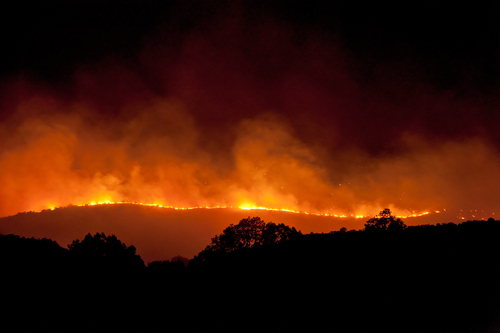The fire had burned 191,607 acres and was 16% contained as of Tuesday, according to the California Department of Forestry and Fire Protection, or Cal Fire. Evacuation orders have cleared out the popular California tourist town, population 22,000, as firefighters try to protect its homes and businesses.
Stephen Volmer, a fire behavior analyst for the California Department of Forestry and Fire Protection, or Cal Fire, said southwesterly winds forecast for Tuesday afternoon would push the fire to the backside of a mountain range that towers above the resort city.
“It’s a better situation than having a direct south wind that could run fire towards the lake,” Mr. Volmer said. However, “areas within South Lake Tahoe are still threatened due to the erratic winds and critical fire behavior.”
A red-flag warning, indicating hot, dry weather and gusty winds that could accelerate the spread of wildfire, is in effect until Wednesday evening. The conditions are keeping firefighters on alert as embers from the fire have been traveling far distances, passing containment lines and creating spot fires in areas three-quarters of a mile to one mile away, according to Cal Fire.
Firefighters on the western portion of the blaze were focusing on saving structures, as the Caldor Fire made its way to more populated areas around South Lake Tahoe, said Tim Ernst, Cal Fire’s operations section chief.
California Gov. Gavin Newsom said fighting the Caldor Fire was the No. 1 priority in the state. “We’re doing everything in our power to have your back,” he said, in a reference to area residents who had to evacuate.
More than 53,000 people in El Dorado County, where the Caldor Fire sparked, now have been evacuated, according to the California Governor’s Office of Emergency Services.
At the Green Valley Community Church in Placerville, Calif., Dale Teach’s eyes moistened when he recounted how he and his wife, Julie, barely escaped with their lives when the Caldor Fire tore through their community of Grizzly Flats, southwest of Lake Tahoe, on Aug. 17.
“The flames were coming and the embers were dropping,” said Mr. Teach, who had just moved into a new cabin outside the community three days before. The cabin and all the other property left behind, including a prized race car, were reduced to rubble, he said.
“At 55, I thought I could retire,” said the carpenter, dabbing at his eyes. “I’ve been crying for days.”
One of the chief dangers of the Caldor Fire now is that some of the many embers being thrown into the valley behind South Lake Tahoe will ignite the tinder-dry forest, homes—or both, said Rick Stratton, a national fire analyst with the forest service who has been tracking the blaze.
Key to minimizing damage, he said, is whether a regimen of tree thinning there in recent years is enough to slow the fire spread and whether homes that encounter an ember are designed with fire-resistant materials. “Hopefully they can engage the fire down below,” Mr. Stratton said, of firefighting efforts. “Hopefully you don’t get many homes go up at the same time.”
The Lake Tahoe Basin’s vulnerability to wildfire has been of such local concern that the region, home to about 50,000 people and a tourism-based economy of about $5 billion a year in revenue, has embarked on aggressive tree-removal operations from the dense conifer forests that surround it.
One of the largest was a 10,000-acre thinning project near South Lake Tahoe that was commissioned after the 2007 Angora Fire blackened 3,100 acres and about 250 homes there.
With fires burning across the state, the U.S. Department of Agriculture Forest Service’s Pacific Southwest region said it would close all of California’s national forests, beginning Tuesday evening.
The decision was made, in part, to prevent any new fires from starting in the state amid drought conditions and to prevent visitors from being trapped on forest land during an emergency.
“We do not take this decision lightly but this is the best choice for public safety,” said Regional Forester Jennifer Eberlien. “It is especially hard with the approaching Labor Day weekend, when so many people enjoy our national forests.”













